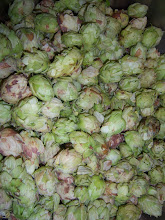 |
| This look says it all, doesn't it? |
English Sour Brown Something-Or-Other pours a rustic orange copper with a thin wispy white head that is ephemeral at best. Still, there is active carbonation, with small, tiny bubbles streaming up the sides of the glass. In the nose, there is
 brown malt, graininess, cereal (like Cheerios), and a hint
of lactic acid, followed by an earthy mustiness mixed with dark stone fruit
aromatics—cherries and figs, mainly. The latter part kind of reminds me of the
smell of my grandparents’ house from my childhood. I also get a hint of
something spicy verging on adhesive in the background—the ol’ classic dirty
band-aid coming to the party. The beer opens with malt, specifically cereal and
bread dough flavors, and a slight vinous fruit slickness that gives the beer a
thin feel on the palate. It brightens and sharpens as it runs into the middle,
with a combined light lactic tang and a brettanomyces
gaminess to it—it is just short of funky. There is more fruit in the middle,
albeit a more rounded, brighter fruitiness that pairs well with the wild yeast
flavors. This leads to a bright candy lactic twang in the finish (which I
like), followed by some grain huskiness and astringency that lingers, along
with flavors from the darker grains (which I don’t like). The initial thin
mouthfeel gives way to more substance in
brown malt, graininess, cereal (like Cheerios), and a hint
of lactic acid, followed by an earthy mustiness mixed with dark stone fruit
aromatics—cherries and figs, mainly. The latter part kind of reminds me of the
smell of my grandparents’ house from my childhood. I also get a hint of
something spicy verging on adhesive in the background—the ol’ classic dirty
band-aid coming to the party. The beer opens with malt, specifically cereal and
bread dough flavors, and a slight vinous fruit slickness that gives the beer a
thin feel on the palate. It brightens and sharpens as it runs into the middle,
with a combined light lactic tang and a brettanomyces
gaminess to it—it is just short of funky. There is more fruit in the middle,
albeit a more rounded, brighter fruitiness that pairs well with the wild yeast
flavors. This leads to a bright candy lactic twang in the finish (which I
like), followed by some grain huskiness and astringency that lingers, along
with flavors from the darker grains (which I don’t like). The initial thin
mouthfeel gives way to more substance in  the second half of the beer, and the
lactic bite makes up for the minimal carbonation—it provides the bite and
crispness the beer needs to finish effectively. The lingering graininess and
astringency gums up an otherwise enjoyable beer—the dark grain flavors don’t
sit well with some of the other components of the beer, giving a sharper, rough
edge to the slight acetic acid flavors that linger longest on the palate. The
strengths of the beer—its soft subtlety of Flanders Red/Oud Bruin
characteristics—are counteracted by the stronger, more overpowering finish. You
should try this beer again, Chris, but cut the chocolate and roast malt (is
there biscuit malt as well?) and replace it with something like dark Munich or
Special B to give the beer a softer malt profile that will better balance the
finish. Or, in other words, keep it subtle, but make the malt bill more
Belgian.
the second half of the beer, and the
lactic bite makes up for the minimal carbonation—it provides the bite and
crispness the beer needs to finish effectively. The lingering graininess and
astringency gums up an otherwise enjoyable beer—the dark grain flavors don’t
sit well with some of the other components of the beer, giving a sharper, rough
edge to the slight acetic acid flavors that linger longest on the palate. The
strengths of the beer—its soft subtlety of Flanders Red/Oud Bruin
characteristics—are counteracted by the stronger, more overpowering finish. You
should try this beer again, Chris, but cut the chocolate and roast malt (is
there biscuit malt as well?) and replace it with something like dark Munich or
Special B to give the beer a softer malt profile that will better balance the
finish. Or, in other words, keep it subtle, but make the malt bill more
Belgian. From one of Chris’s rambling Facebook posts: “Lactic and funky with nice body and no bitterness.”
(9/27/2013)

No comments:
Post a Comment